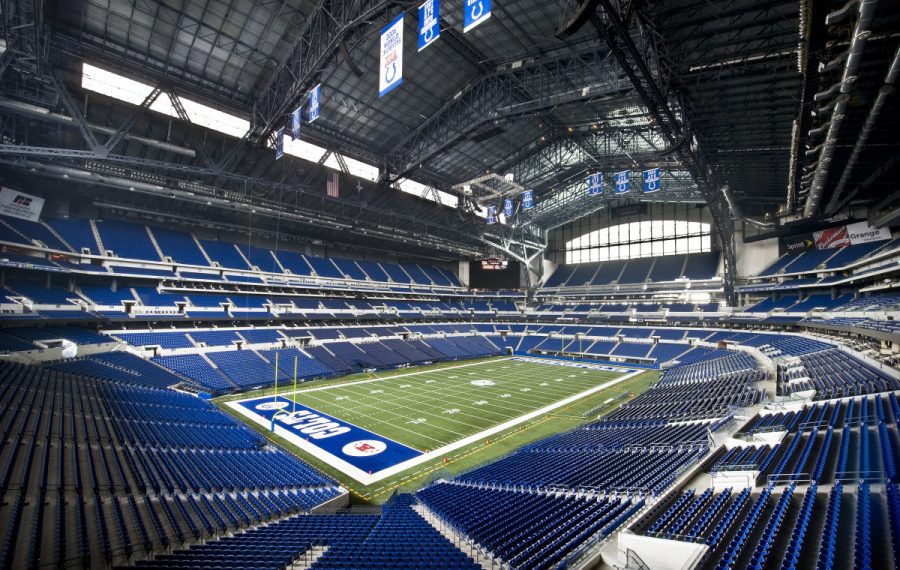Sports franchises must stop dipping into tax dollars
Using public money to pay for stadiums is wasteful and misleading
More stories from Deanna Kolell
Photo by SUBMITTED
The Indianapolis Colts set a record when taxpayers funded $619 million of the $719 million dollars it cost to construct Lucas Oil Stadium.
Rival sports teams will always look to become bigger and better than their competitors, and this includes their stadiums. Especially recently, sports stadiums have become increasingly extravagant, some including luxuries like swimming pools and aquariums.
Using public money to fund these so-called state-of-the-art stadiums may seem like a way to support the team, but instead of generating revenue, team owners don’t follow through on their promises by taking money they don’t need and holding cities and counties hostage.
Judith Grant Long, professor of urban planning at Harvard University, estimated that between 2001-2010, taxpayers provided $12 billion to build 51 stadiums. Despite this, NFL, NBA, NHL and MLB owners average a net worth of over $2 billion.
The NFL is the worst offender among the among the major sports leagues in the United States. According to Fox Sports, taxpayers provided $4.76 between 1997-2015 for 20 new stadiums.
In fact, five NFL teams each have received more than $400 million in tax dollars to fund construction of a new stadium or renovation of a current stadium, including the Atlanta Falcons, Minnesota Vikings, Cincinnati Bengals and Dallas Cowboys.
However, the Indianapolis Colts set a record when they received $619 million in public funding for the $719 million Lucas Oil Stadium. This sum of money paid by tax dollars still remains the largest in history. And the Colts’ franchise is worth $1 billion.
These franchises obviously are more than capable of footing the bill when building a new stadium, and some teams have done so. When MetLife Stadium was built in New York, the $1.6 billion project did not dip into taxpayers’ pockets.
So why are taxpayers continually being saddled with the bill? It’s partially because franchises and owners know they hold power over their constituents. They act like whiny children who threaten to take their toys someplace else if they don’t get their way.
The common threat of NFL teams — so common, it’s become a cliche — is that they will relocate to Los Angeles if they did not get funds for their stadiums. At some point, the Oakland Raiders, San Diego Chargers and St. Louis Rams have all threatened to do so, and last year the Rams followed through. Earlier this year, the Chargers announced they would move as well.
According to PBS, Missouri and St. Louis offered to give the Rams $400 million for their new stadium, but they decided to move anyway, and their owner Stan Kroenke would spend his own $1.9 billion to build a stadium.
In the same way, the Chargers asked the city of San Diego for $350 million for their $1 billion stadium. The team had the option to move to Los Angeles and share the Rams’ new stadium for two years.
Teams like the Rams and Chargers hold a lot of power in their ability to hold cities and counties hostage until they receive their funds. There’s a word for obtaining money through threats; what these teams are doing is extortion.
Moreover, the promises of new jobs and increased revenue almost never follow the building of a new stadiumw. In 2008, economists analyzed 20 years of data and concluded there is no evidence that building new stadiums create jobs or increase incomes or tax revenues.
Roger Noll, a former chief economist for the President’s Council of Economic Advisers also found that “stadiums do not generate significant local economic growth, and the incremental tax revenue is not sufficient to cover any significant financial contribution by the city.”
Rather than creating jobs and revenue, more often than not, building new stadiums drives cities and counties deeper into debt by raising taxes. In 2013, the city of Detroit entered bankruptcy, yet taxpayers still covered $283 million of the $444 million Red Wings’ arena.
The Cincinnati Bengals were also guilty of burying Hamilton County in Ohio in debt. The team threatened to leave unless they got a new stadium and to cover the costs, the county had to sell a public hospital, cut 1,700 jobs and delay payments for schools.
Taxpayers give league owners too much power and decision making ability when it comes to new stadiums. Teams are able to hold cities hostage, extort them for funds and keep all the revenue. Meanwhile taxpayers are left on the hook for years.
Sports leagues are private industries, so why should they use public money to fund private stadiums rather than necessities like roads and schools? The time has come to free cities by cutting league owners loose from taxpayer money.


